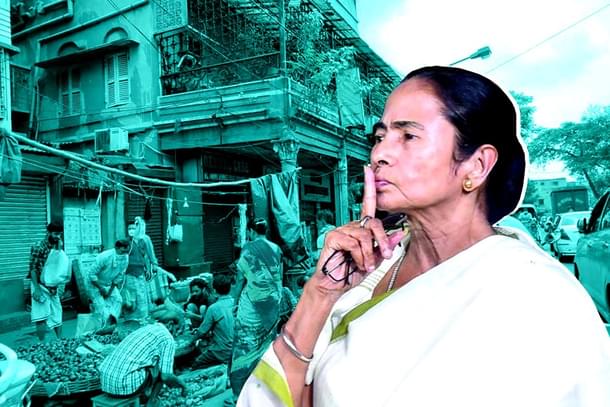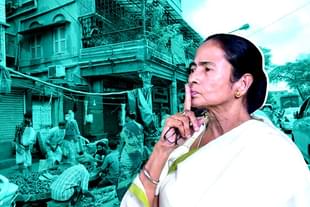Politics
The Many Times That Mamata Banerjee Displayed Her Strongly Mercurial Streak And Acted Out Of Blind Rage
Jaideep Mazumdar
May 18, 2021, 04:22 PM | Updated 04:22 PM IST
Save & read from anywhere!
Bookmark stories for easy access on any device or the Swarajya app.


Bengal Chief Minister Mamata Banerjee storming into the CBI office in Kolkata on Monday (May 17) in a bid to get her arrested party leaders released was not the first time she acted in a fit of anger and tried to take the law into her hands.
Throughout her political career, she has been known as a stormy petrel and a highly mercurial lady whose mood can swing instantly from happiness to blind rage.
She is well known to be temperamental and even her senior party leaders are wary of speaking up in front of her out of fear of the frequent tongue-lashings she frequently subjects them to.
One of the earliest capricious acts of Mamata Banerjee in public was when she was just about 20 years old and a member of the Chatra Parishad, the Congress’ students’ wing.
Sometime in April 1974, Jayprakash Narayan landed in Kolkata to rally the masses behind his Sampoorn Kranti (total revolution) against the Union Government led by Indira Gandhi.
In a bid to stop him from entering Calcutta (as Kolkata was known then), Mamata Banerjee, along with a few dozen Chatra Parishad activists, stopped his car outside the airport and laid siege to it.
She then climbed on the bonnet of the car and stomped her feet on it angrily, all the while mouthing expletives against Jayprakash Narayan.
That is when she was noticed by the Congress leadership of Bengal, including the then chief minister Siddharth Shankar Roy.
She was rewarded and made the general secretary of the Bengal unit of the Mahila Congress the next year.
Veteran Congress leaders and her own senior party colleagues who were in the Congress earlier remember her (Mamata Banerjee) as a highly temperamental leader with a quick temper.
They also recall her highly whimsical character and actions and say that many always preferred to keep a safe distance from her.
She always had a sharp tongue and one was never sure how she would react to a particular situation or statement.
Even leaders like Somen Mitra and Subrata Mukherjee (both joined Trinamool later) who were her seniors in the Congress used to treat her with a fair bit of trepidation.
She was made a Minister of State for human resources development, youth affairs and sports by Prime Minister P.V. Narasimha Rao in 1991.
But two years later, she announced at a Congress rally at Kolkata’s Brigade Parade Ground that she would resign from the ministry in protest against the Union Government’s indifference to her proposals to improve sports in the country.
She even took to the streets of Kolkata in protest rallies against her own government and Narasimha Rao ultimately sacked her.
In April 1996, she intensified her pitch against her own party (Congress) and dubbed it as a stooge of the ruling CPI(M) in Bengal. She organised protests against the Congress even while being a party member!
She ultimately walked out of the Congress and launched the Trinamool in 1998. The next year, she joined the NDA government at the Centre led by Atal Behari Vajpayee.
But her tantrums started soon after and she often sat out of the NDA coordination committee meetings, often for frivolous reasons.
Senior NDA leaders, including NDA convenor George Fernandes and even Prime Minister Vajpayee, made many attempts to placate her and even reached her residence at Kolkata’s Harish Chatterjee Street.
But she persisted with her whimsical ways and often grumbled, protested and threw political tantrums. Senior leaders bending over backwards to humour and placate her perhaps emboldened her to persist with and even step up her antics.
In 2000, she resigned from the cabinet in protest against a fuel price hike, but withdrew her resignation very soon.
She resigned as railway minister from the Vajpayee government in 2001 when the Tehelka sting operation tapes showing then BJP president Bangaru Laxman and defence minister George Fernandes’ close aide Jaya Jaitley accepting bribes were released.
Mamata Banerjee has then attempted to take the high moral ground by contending that she could not be part of a government comprising ‘corrupt’ people.
It is nothing but poetic justice that Tehelka is also the source of her current troubles: a sting operation carried out by the news portal in 2014 showing many senior Trinamool leaders accepting wads of currency notes as bribes is what had led to Monday’s arrest of the four Trinamool leaders.
After walking out of the NDA, she quickly joined hands with the Congress and the two parties (Congress and Trinamool) fought the 2001 Assembly polls as allies. But the alliance lost badly and Mamata Banerjee went into near political wilderness.
Banerjee then sent feelers to Vajpayee and the latter, despite saner counsel from senior BJP leaders who argued against granting Mamata Banerjee a fresh political lease of life, inducted her once again in his ministry in 2003.
But she remained a minister without portfolio and only in January 2004 she was given charge of coal and mines portfolio. Many BJP leaders were against giving her any ministry, but Vajpayee, being a magnanimous gentleman, overrode them.
Mamata Banerjee, after defeating veteran communist leader Somnath Chatterjee from Jadavpur Lok Sabha seat in 1984, became one of the youngest parliamentarians of the country at the age of 29.
She became part of Rajiv Gandhi’s infamous ‘shouting brigade’ in Parliament. This ‘brigade’ — a bunch of young MPs, the other prominent members were S.S. Ahluwalia, Suresh Pachauri, Ratnakar Pandey and Baba Mishra — would often shout down any opposition MP who would get up to criticise Rajiv Gandhi or Sonia Gandhi.
Many say that is when Mamata Banerjee honed her shouting and disruptive skills.
She and the other members of the ‘shouting brigade’ would scream angrily on top of their lungs and storm into the well of the House every time any opposition MP attempted to criticise Rajiv or Sonia.
Year later, on August 4, 2006, she stormed into the well of the Lok Sabha and angrily hurled papers at the deputy speaker Charanjit Singh Atwal in protest against Speaker Somnath Chatterjee’s refusal to allow a discussion on illegal influx and large-scale presence of millions of Bangladeshis in Bengal.
Banerjee dramatically announced her resignation from the Lok Sabha while storming out of the House in a fit of rage.
She contested the 2009 Lok Sabha polls in alliance with the Congress and joined the UPA government led by Manmohan Singh. She became the Railway Minister for the second time and took the Indian Railways deep into the red through her whimsically populist measures.
She stepped down as Railway Minister in 2011 to become the Chief Minister of Bengal after her party won the Assembly polls that year.
But her ties with the Congress, her ally at the state and national levels, remained testy and she continued to try to bully the Congress and hold the Manmohan Singh government to ransom.
In September 2012, she announced withdrawal of support to the UPA government over the latter’s decision to hike the price of fuel and allow MNCs into the retail sector.
Mamata Banerjee often mocked and disparagingly mimicked Manmohan Singh. She drew widespread condemnation when, while appearing in a TV interview in October 2012, she mimicked Manmohan Singh.
In January 2013, she complained at a public rally that the Centre was ignoring her demands for Bengal and short of beating the Prime Minister (Manmohan Singh), she had done everything to get his attention. That remark was also widely condemned.
In 2012, the manner in which she forced her senior party colleague and Lok Sabha MP Dinesh Trivedi to resign as Railway Minister (he became the Railway Minister after she vacated that berth and became the chief minister in 2011) because Trivedi had dared to go against her wishes and raised railway passenger fares was appalling and devoid of even basic decorum.
In November 2006, Mamata Banerjee stormed into the lobby of the state Assembly shouting at the top of her voice that she had been disallowed from going to Singur (where the agitation against acquiring farmland for the Tata Motors project had started).
Egged on by her, Trinamool MLAs went on a rampage inside the Assembly, breaking furniture, uprooting microphones, smashing glass panes, attacking security personnel and chasing away CPI(M) legislators.
There are many instances of Mamata Banerjee taking the law in her hands. The most outrageous among them is her storming of the Bhowanipore police station in November 2011 (six months after she became the chief minister) to free two hooligans who were Trinamool party members from custody.
The two hooligans were part of the group who clashed with police and vandalized police vehicles. Mamata Banerjee led a huge group of party supporters to the police station and asked the police officers to release the two.
She also shouted at and abused the then commissioner of police Ranjit Pachnanda and other senior police officers who had reached the police station.
In early February 2019, Mamata Banerjee unleashed her police on the CBI which had gone to Kolkata Police commissioner Rajeev Kumar’s residence to question him on the Saradha chit fund scam (read this).
Kumar was the head of a special investigation team formed by the Mamata Banerjee government to probe the scam before the Supreme Court handed over the probe to the CBI.
Kumar was accused of destroying evidence to protect senior Trinamool leaders who allegedly benefited from the scam.
The CBI team which went to question the Kolkata police chief was taken away and detained at a police station while police teams went to the residence of a senior CBI officer Pankaj Srivastav in a bid to arrest him, his wife and teenage daughter.
Kolkata Police teams also laid siege for a few hours on the offices of the CBI at the central government office complex at Nizam Palace in Kolkata.
Mamata Banerjee reached the Kolkata Police commissioner’s residence in a fit of rage and started staging a dharna in front of it against the CBI’s action.
Thus, Monday (May 17) was not the first time she tried to take the law into her hands and stop the CBI from performing its duties.
Among her many ‘angry acts’ in recent years was her branding a Presidency University student who asked her some uncomfortable questions on a popular TV show in May 2012 a ‘Maoist’ (read this) before tearing off the microphones and storming out of the show.
In August 2012, Banerjee branded a farmer who dared ask her about steep fertilizer prices at a public interaction with farmers a ‘Maoist’ and had him imprisoned (read this).
Mamata Banerjee is widely known to be extremely intolerant and does not take kindly to any criticism. She is also quick to fly into a rage and is alleged to often abuse and insult even her senior cabinet colleagues.
A close study of her political career will reveal that Mamata Banerjee stormed into the CBI office at Nizam Palace on Monday and demanded the release of the four arrested because she assumed she would get away with it.
That’s because she had gotten away with taking the law into her hands, or displaying scant regard for the law, in the past. She had gotten away with throwing tantrums, making unreasonable demands, trying to hold governments to ransom and much worse.
Political observers say that had she been made responsible and made to pay a steep price for her actions and misdeeds in the past, she would not have mustered the courage to storm the CBI office on Monday.
But, at long last, things did not go her way and her actions boomeranged badly on her.
Jaideep Mazumdar is an associate editor at Swarajya.





